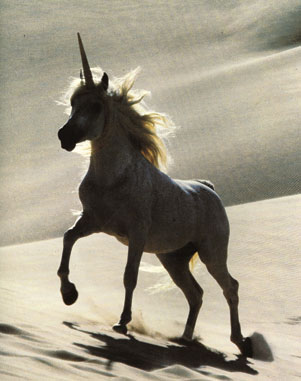Back to the Arabian unicorn December 6, 2010
Author: Beach Combing | in : Contemporary, Medieval , trackback Beachcombing – three long moons ago – ran an article on a European sighting of two unicorns at Mecca (of all places) in the sixteenth century. Given his bewilderment at the time he feels obliged to add this fascinating fragment that he recently stumbled upon.
Beachcombing – three long moons ago – ran an article on a European sighting of two unicorns at Mecca (of all places) in the sixteenth century. Given his bewilderment at the time he feels obliged to add this fascinating fragment that he recently stumbled upon.
Strangest of all [the mythical beasties of south-west Arabia] is the Tahish. It is a fearsome beast, half animal and half jinni, which inhabits the mountains of the Yemen. It has frequently been described to me, and the descriptions vary little and only in detail. The Tahish lives in the less accessible rocks of the hills, and by day watches the valleys and hill tracks. By night it descends upon its chosen victim, but seems to do him little harm beyond giving him the fright of his life. It is the size of a large horse, with a horse’s head and mane, and neighs like a stallion, only with a more ringing and brassy note. Its eyes are luminous and a sign of the evil eye-pale blue. It is higher at the withers than at the quarters and has a lion’s tail, which is often described as being lashed from side to side. From the corners of its horse’s mouth project long, sharp tusks, usually flecked with bloody foam. Its feet are apparently variable, for it has camel’s feet to enable it to approach you noiselessly, and horse’s hoofs wherewith to stamp on the rocks and disperse your caravan. In colour it is a sandy grey. Should you indeed be one of the elect – a man of stainless record, an innocent child or a virgin (women of stainless records, once married, do not count) – it will not attack you. All others should fly and hide at its approach. But woe betide the hapless wretch who is cornered by a Tahish when it is out for blood! There is believed to be no hope for such an one, though I could never hear of anyone who was supposed to have been killed by a Tahish. No knife can pierce the Tahish’s hide, no bullet find a vital spot. Only the bravest of the brave can survive, and he only if he springs forward and snatches a particular hair from the Tahish’s forehead. This hair is described as being about a yard long; black and silky, and coiled round in a single curl. Should a man seize this, pull it out and retain it in his hand, the Tahish will vanish away and never be seen again. This hair is a powerful talisman. Opinion is divided as to whether its possession renders the possessor irresistible in love, but it is generally acknowledged that it confers invulnerability and omniscience in war, and, by stampeding the enemy hosts before a shot is fired, makes vain the carrying of other arms.
This account comes from the pen of Robert Hamilton, the twelfth lord of Belhaven who served his country from1931-1946 in Aden, commanding the Camel unit for the first five. Here was someone who had then often left the confines of the city and had gone deep into the Yemenese interior.
The Tahish and the Unicorn (as understood by we moderns) have three points in common: the horse-like dimensions, a respect for virgins and the hair (horn?) growing out of the centre of the forehead.
Nor has the Tahish vanished – one lovely account includes it in the list of modern Yemenese monsters along with ‘cannibal witches who eat their victims as a gravy, become pregnant, give birth to a cat-like creature with oversized sexual organs and – alas, then the narrative becomes too much for a family newspaper’.
It is interesting that, in a recent article (2002), Jaroslav Stetkevych, argued that the unicorn legend has its origin in Arabia or on the edges of Arabia.
In sum, Beachcombing is now more confused than when he began – always a good sign.
Any more dirt on the Tahish? drbeachcombing AT yahoo DOT com
***
7 Dec 2010: Dennis wrote in with this extraordinary Chinese picture and story. Thanks Dennis!



